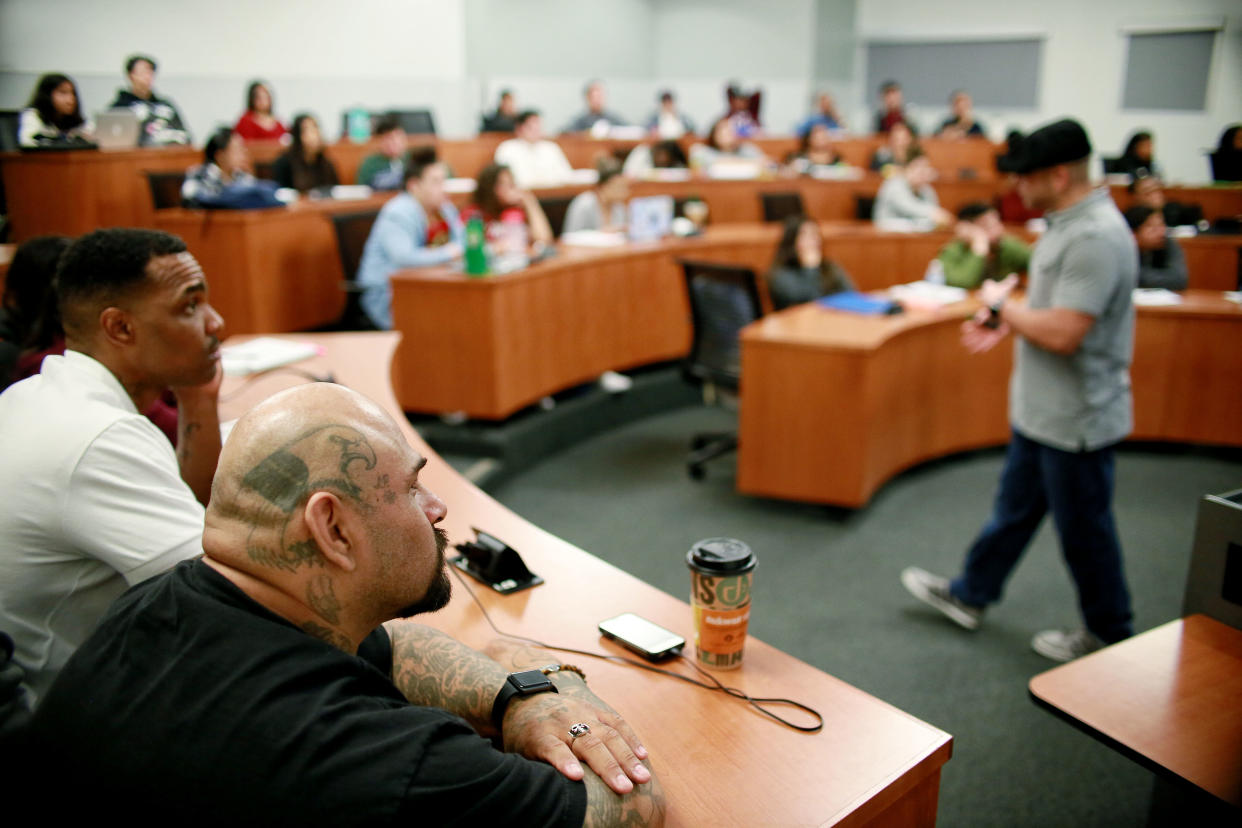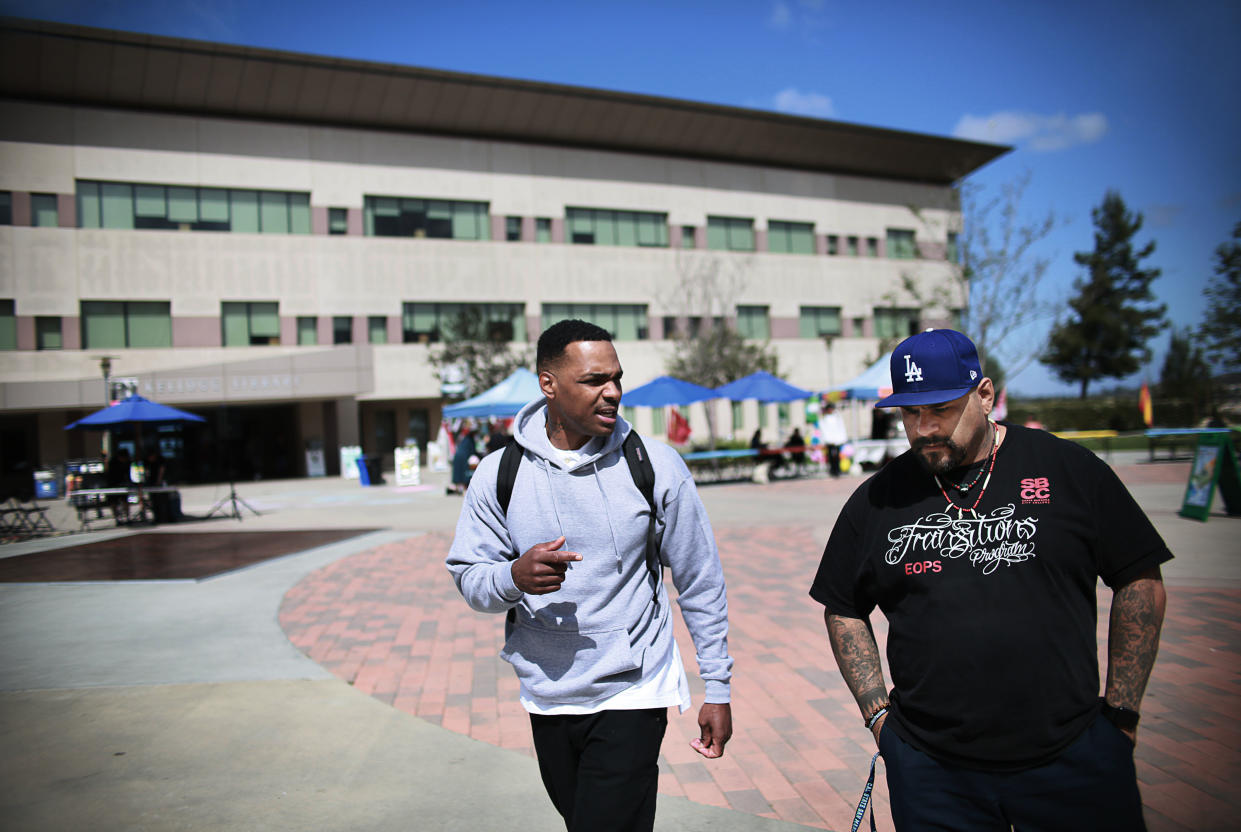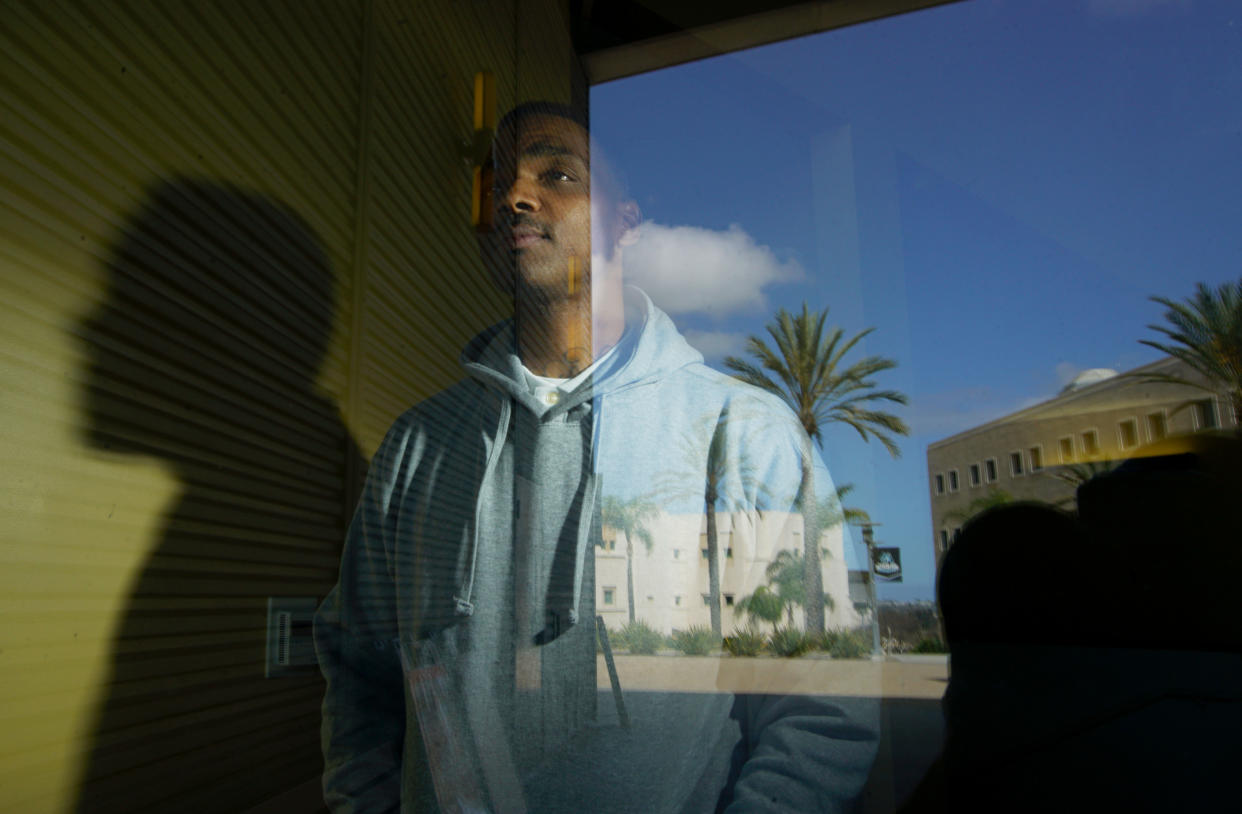California leads the nation in sending former inmates to college. Will other states follow?

After years behind bars at Kern Valley State Prison and the state lockup in Chino, Calif., Martin Leyva had grown accustomed to the brutal violence and volatility of prison life. Showing up for his first day of college following his release, on the other hand, was truly frightening.
Leyva got off the bus in 2007 at Santa Barbara City College, looked up at the buildings, but couldn’t bring himself to step onto the campus. Shaking, he turned around and returned to his sister’s house in the nearby town of Goleta.
“I was terrified. I never felt so out of place in my life,” Leyva, now 45, told Yahoo News. “When I got home, my niece asked me how it went. I told her I got too scared. Here’s a person who’s lived in prisons and jails for so long that that life became normal.”
During his childhood, Leyva’s family regularly moved between poor neighborhoods in the otherwise affluent city of Santa Barbara. Leyva lived in projects on the Lower West Side of town and is still known locally as “Martin from the West Side.” With no male role model in the home, he turned to the streets for affirmation, but a life of crime and multiple drug and robbery arrests soon found him cycling through juvenile hall, county jail and prison. He dropped out of high school in the ninth grade but got his GED by doing work packets from inside Santa Barbara County Jail.
In some ways it took going to prison for him to realize that he didn’t belong there.
“I met a couple of elders who were different. They would say stuff like, ‘When you get out of prison, stay out of prison. You don’t belong.’ One of my elders said, ‘Get out and help the people.’ I don’t know what he meant, but I really took it to heart this time. Something completely shifted inside of me,” Leyva said.
After leaving prison for the last time at 34, Leyva’s main goals were to stay out of prison, get a job and provide for his two daughters. But like so many young men who grew up on the street, he didn’t know how to make an honest living. That’s when his niece suggested he give college a shot.
“My niece saved my life. She said, ‘I’m going to take you myself to the school.’ We went the next day. She showed me what was going on there. So many things that can be so intimidating,” Leyva said.
Several Santa Barbara City College professors helped foster his love of learning. Leyva, who identifies as Chicano, began to understand his own incarceration in the context of a larger societal trend that was landing minority men in jail. He thrived academically and went on to earn a bachelor’s degree in psychology at Antioch University in Santa Barbara. Now he’s living in the San Diego area and is on track to earn a master’s degree in sociology this spring from California State University San Marcos. He intends to apply to PhD programs next year.

“The interesting thing about going to college for someone like me is that my story is not unique,” Leyva said. “For the last 10 years I’ve been working with a lot of formerly incarcerated individuals. It’s across the board.”
Indeed, Leyva’s turnaround is hardly unique in California. The Stanford Criminal Justice Center and the Opportunity Institute released a report last month showing that the state was able to change the prospects for thousands of current and former inmates dramatically through access to higher education.
According to the Stanford report, nearly 4,500 inmates were enrolled in face-to-face community college classes in the fall of 2017 — more than in any other state. Hundreds more were waiting to enroll. But the move to educate prisoners is also new to California. Just three years ago, there wasn’t a single inmate enrolled in a face-to-face community college class inside the state prison system.
The recent push to reform California’s criminal justice system is helping to counteract specific policies that caused the prison population to balloon in the ’90s. Originally enacted in 1994, California’s Three Strikes sentencing law required that a defendant of any new felony with one previous serious felony conviction be sent to state prison for double the sentence the crime would otherwise receive. If the defendant had two or more prior felony convictions, he or she would receive a state prison sentence of 25 years to life. This law exploded the prison population and is widely seen today as a major mistake.
In 2011, the U.S. Supreme Court ordered California to reduce its severely overcrowded prisons, which led Gov. Jerry Brown and the state Legislature to come up with a variety of ways to get them back into the civilian population.
In 2012, voters approved Proposition 36, which significantly changed the Three Strikes law so that, in order to receive a 25-year-to-life sentence, an offender must be convicted of a “serious or violent felony.” The new law also allowed prisoners convicted under Three Strikes to petition for reduced sentences.
At the same time, California has also worked to give released convicts like Leyva the opportunity to attend college, and in 2014 Brown signed a law that allows community colleges to offer face-to-face classes inside state prisons and to be compensated for the teaching.
In 2016, voters passed Proposition 57, which intends to “stop the revolving door of crime by emphasizing rehabilitation.” It allows nonviolent offenders to seek earlier parole if they served the full-term sentence for their primary offense and can demonstrate that they would not pose a risk of violence to the public. It also established opportunities to earn credits for good behavior as well as participation in in-prison rehabilitation programs.

Most other states’ public colleges ask about criminal records on their applications. A handful — including Washington and Louisiana — don’t. California’s public colleges have never had undergraduate admissions barriers for people with criminal histories, and incarcerated and formerly incarcerated students are also eligible for the California College Promise Grant.
As a result of these and other initiatives, thousands of former prisoners are now attending the University of California, California State University and California community colleges. A third of the state’s 114 community colleges and CSU campuses have support groups for formerly incarcerated students.
“For decades we’ve been locking people up and letting them go, telling them to get a job and getting surprised at high recidivism rates. We need to do something a little bit differently,” Rebecca Silbert, co-author of the Stanford report, told Yahoo News. “Higher ed is not the answer, but it is one answer. If it is a potential answer, we should grasp it and make the best of it.”
A senior fellow at the Opportunity Institute in Berkeley, where she directs the Renewing Communities project, a statewide initiative to promote educational opportunities for Californians with criminal records, Silbert said a consensus is emerging that access to higher education is a key factor in reducing prison recidivism rates.
“This has been able to happen because we had a policy framework in place that really values and makes higher education accessible to everyone,” Silbert said. “California, like all states, we’re struggling with higher ed, but we have at its core our master plan and a true state belief that everyone should be able to access the system.”
The United States holds the dubious distinction of leading the world in locking people up. The American Civil Liberties Union (ACLU) reports that the U.S. holds 25 percent of the world’s inmates despite making up only 5 percent of the world’s population, and that it costs anywhere between $20,000 and $50,000 for local, state or federal governments to lock up an individual each year. Altogether, the U.S. spends roughly $80 billion on incarceration annually.
“Tough on crime” rhetoric and policies of the 1980s and 1990s helped fuel the incarceration epidemic. The so-called war on drugs, for instance, has not led to a decline in drug use despite the federal government’s spending an estimated $1 trillion since the 1970s. Over that same time, millions of people — disproportionately black and brown people — have been locked up. In fact, one quarter of all the people currently incarcerated in the U.S. were arrested on drug charges, according to data compiled by the ACLU.
“We didn’t used to be like this. If you look at the history, this started not that long ago,” Silbert said. “The wrong policies in the wrong hands at the wrong time.”
Fortunately, Silbert said, California has changed course over the past four years and shown the valuable role higher education can play in stopping the revolving door of recidivism.
“The students are advocating for it, coming out of the shadows saying, ‘We deserve an education too,’ at the same time the governor, chancellors and legislators are saying, ‘We need to do this,’” Silbert said, adding, “We’re saying higher education needs to be for everyone, including men and women who are inside custody and have been and are trying to change their lives.”

Tolani Britton, an instructor at the Harvard Graduate School of Education, still sees political will as a major challenge to increasing college enrollment for formerly incarcerated people. States with Republican governors and legislatures, Britton says, tend to be less interested in social programs and more interested in “tough on crime” policies.
“An unknown in the equation is the ways in which persons and municipalities that depend on incarceration, such as prison guard unions and districts that receive representation [in state legislatures] through prison gerrymandering, will react to proposals to increase access to college for incarcerated persons,” Britton told Yahoo News in an email.
Sociologist Joshua Page’s 2013 book, “The Toughest Beat,” shows how the prison officers union helped to shape California’s policies and incarceration rates. More recent research by the Vera Institute of Justice shows that California is one of the states with the highest salaries for prison guards and that though the prison population decreased by 21 percent from 2010 to 2015, costs actually increased by 7 percent.
“It is important not to demonize prison workers, who ultimately work under difficult conditions and have higher than average rates of PTSD and suicide,” Britton said. “However, it can certainly be argued that prison worker unions have generally argued for tough-on-crime policies to benefit their members, and they have political influence.”
Britton said another limitation for other states adopting California’s policies that make it easier for former inmates to attend public schools is that there might not be as many community colleges for the potential students. California is the state with the greatest number of community colleges. Other states with many community colleges, such as Illinois and New York, will find it easier to start comparable programs compared to states with few public colleges, she said.
Britton pointed out that outcomes for other states will be important. She cited National Student Clearinghouse’s data that the average six-year completion rates for first-time students at two-year colleges is about 39 percent.
“Given the relatively low success rates for first-time students without some of the challenges of incarcerated persons, programs will need to demonstrate that they can graduate formerly incarcerated students in order to demonstrate the return on investment. This will be a challenge in the face of limited resources and political skepticism,” she said.
However, Britton said, there is a “strong and growing body of research” on the positive effects that a college degree has on reducing recidivism. Research by PrisonEducation.com and others shows that the likelihood of recidivism is inversely correlated with a former inmate’s level of education. Between 70 and 80 percent of American prisoners return to prison, but this is cut to 13.7 percent for those who have earned an associate’s degree, to 5.6 percent for those with a bachelor’s degree and 0 percent for those with a master’s degree.

And it’s not just the inmates who could benefit. Britton suggested that a convincing argument for educating prisoners is that doing so decreases incarceration costs, saving a state money in the long run.
According to the RAND Corp., a nonprofit policy think tank, $4 to $5 is saved on incarceration costs for every dollar invested in correctional education.
Former President Barack Obama cited this statistic in an article on criminal justice reform for the Harvard Law Review. “Studies have shown that inmates who participate in correctional education programs have significantly lower odds of returning to prison than those who do not,” Obama wrote, “and that every dollar spent on prison education saves four to five dollars on the cost of reincarceration.”
In Leyva’s first year at Santa Barbara City College, he struck up a conversation with fellow students he had seen at his parole office and ultimately founded a program called Transitions. It started out as a support group for formerly incarcerated students. First, they met near a park bench, then the school let them use a room. Now, a decade later, Transitions has evolved into a summer program in which formerly incarcerated students get together to support each other and prepare for the fall and spring semesters ahead. Leyva said that 85 percent of people who have gone through the program have not returned to jail. He launched another Transitions program at MiraCosta College and is preparing for one at Palomar College this summer.
Timothy Jackson, a student at MiraCosta College in Oceanside, Calif., credits Leyva for giving him and thousands of others a platform through the Transitions collective to become educated.
“My life is different today. I have become an asset to the very community I was once a liability to,” Jackson told Yahoo News. “The college campus has become the safest place for me as I transition from nine years of incarceration to pursuing the highest level of education possible. The men and women who have come alongside of me to foster and mentor this pursuit have empowered me.”

While Leyva’s tattoos and street clothes still raise eyebrows among the administrative staffs on some college campuses, once he starts talking about his plans to help former inmates, the skepticism falls away.
“That stigma is the hardest part. Even though I don’t feel it anymore. I walk into a room and I own my identity. I own who I am and what I’ve done in the past,” Leyva said. “Everywhere you go there are people who don’t want you, but everywhere you go there are people who want to help you.”
Read more from Yahoo News:

